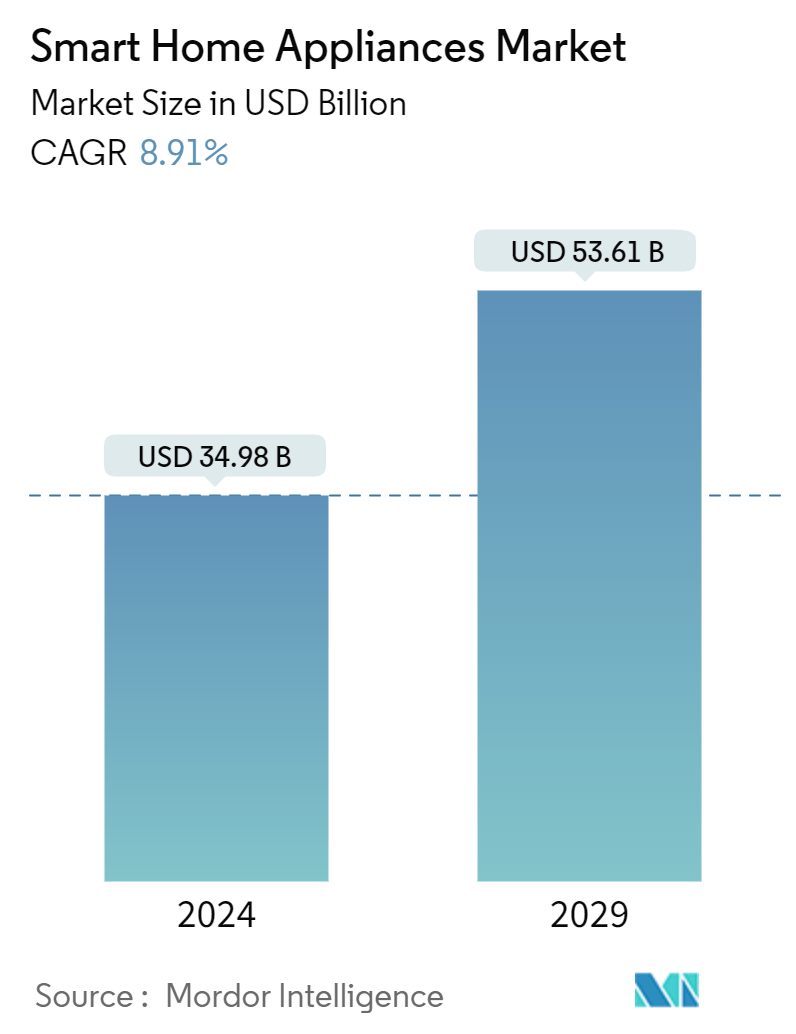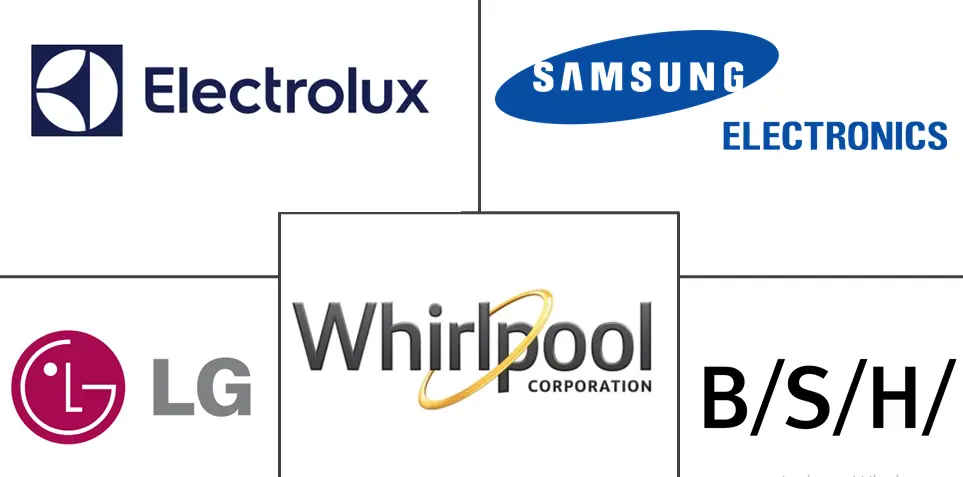Market Size of Smart Home Appliances Industry

| Study Period | 2019 - 2029 |
| Market Size (2024) | USD 34.98 Billion |
| Market Size (2029) | USD 53.61 Billion |
| CAGR (2024 - 2029) | 8.91 % |
| Fastest Growing Market | Asia Pacific |
| Largest Market | North America |
| Market Concentration | High |
Major Players
*Disclaimer: Major Players sorted in no particular order |
Smart Home Appliances Market Analysis
The Smart Home Appliances Market size is estimated at USD 34.98 billion in 2024, and is expected to reach USD 53.61 billion by 2029, growing at a CAGR of 8.91% during the forecast period (2024-2029).
The Internet of Things has expanded across smart home applications, and it is anticipated to become more configurable to provide users more control and improve how the appliances operate. Consumer Technology Association predicts that by 2022, connected home goods will bring in $5.94 billion in revenue in the United States.
- The next generation of traditional home appliances, known as "smart" appliances, are outfitted with advanced technologies for receiving, processing, and transmitting data using smartphones, tablets, and laptops. The U.S. Energy Information Administration projects that by 2035, the world's energy demand will have increased by almost 37%. The use of smart home appliances would rise in such a situation because they enable real-time communication to operate the gadget at low frequencies or move the operation time to off-peak hours. As a result, smart home appliances give both consumers and service providers enhanced control functions and greater comfort, security, and efficiency.
- Businesses in the market have been concentrating on improving food recognition and integrating it into kitchen applications like full-size ovens and refrigerators. A number of companies, including Bosch, GE, Samsung, and others, have been introducing concepts like a refrigerator that identifies and monitors food, remote monitoring of a stovetop, and integrating artificial intelligence (AI) into appliances for recommendations. Similar to this, smart home equipment for the kitchen is getting more functional upgrades, such as useful notifications, energy-saving appliances, and Wi-Fi capabilities. For instance, smart microwaves can now seamlessly download cooking instructions and read barcodes on food products while also offering AI voice assistants for a completely hands-free experience.
- Similar to this, the CES exhibition in 2021's smart home section had a number of small appliances. The allied smart kitchen gadgets included features that helped users increase cooking efficiency and precision, plan meals intelligently, improve their wellness, and streamline household tasks, among other things. Additionally, it is anticipated that machine vision and food inventory tracking systems will make an appearance in smart kitchen appliances to feature ingredient detection, food readiness, and recommendations in the form of the need to raise or lower the oven temperature or note any missing ingredients. However, smart appliances don't just improve food quality. Smart refrigerators, microwaves, ovens, and other appliances are being developed to help with waste reduction and energy monitoring by warning owners of problems in the kitchen, even when they are physically away from the house.
- Additionally, it has inspired makers of voice assistants to take things a step further by integrating cooking APIs into their platforms. This guarantees control over certain appliances by enabling voice capabilities for essential tasks like setting the cook's temperature and cooking food until it reaches a predetermined internal temperature. The function of the kitchen has changed as well, moving away from being just a place for food preparation and toward becoming a place for entertaining, mingling, dining, and working, among other things. Similar lifestyle adjustments have been made possible by technology. One of the major forces behind the adoption and development of smart and connectable appliances, for instance, is the design of appliances with additional functionality to make them easier to use. Additionally, rising interest in cooking over time has facilitated the growing acceptance.
- The COVID-19 outbreak temporarily reduced the Chinese home appliance industry's manufacturing capacity in the first half of 2020, but the market recovered its strength in the second half. As the people staying at home due to quarantine, the online retail channels experienced a tremendous increase in demand and contributed more than 70% of total revenues in the first quarter. Additionally, the Research Institute of the Ministry of Commerce of China predicted that the Chinese home appliance market would see a concentrated time of rejuvenation, with advantages for both smart and healthy home appliances.
Smart Home Appliances Industry Segmentation
The paper examines the present market environment and significant factors affecting smart home equipment and gadgets. The study's scope includes gadgets that can be connected to a network and controlled from a distance, like tablets and smartphones. The study's scope contains appliances, including ovens, dishwashers, refrigerators, cooktops and cookware, scales, thermometers, and other items. The paper discusses the market trends in particular North American, European, and Asia-Pacific countries.
The smart home appliance market report is segmented by product type (smart ovens, smart dishwashers, smart refrigerators, smart cookware and cooktops, smart scale and thermometers), and geography (North America (United States, Canada), Europe (Germany, United Kingdom, France, Spain), Asia Pacific, and the Rest of the World). The market sizes and forecasts are provided in terms of value (USD) for all the above segments.
| By Product Type | |
| Smart Ovens | |
| Smart Dishwashers | |
| Smart Refrigerators | |
| Smart Cookware and Cooktops | |
| Smart Scale and Thermometers | |
| Other Product Types |
| By Geography*** | ||||||
| ||||||
| ||||||
| ||||||
| Australia and New Zealand | ||||||
| Latin America | ||||||
| Middle East and Africa |
Smart Home Appliances Market Size Summary
The smart home appliances market is experiencing significant growth, driven by advancements in the Internet of Things and consumer demand for more configurable and efficient home solutions. These appliances, equipped with advanced technologies, allow for real-time communication and control, enhancing user comfort, security, and energy efficiency. Companies like Bosch, GE, and Samsung are leading innovations by integrating artificial intelligence and machine vision into kitchen appliances, offering features such as food recognition, remote monitoring, and energy-saving capabilities. The market is also witnessing a shift in the kitchen's role, transforming it into a multifunctional space for cooking, entertaining, and working, supported by smart appliances that offer convenience and ease of use.
The global market for smart home appliances is expanding, with significant contributions from regions like China and Japan, where high awareness and investment in connected devices are prevalent. The COVID-19 pandemic has further accelerated the adoption of smart appliances, as consumers sought convenience and efficiency while spending more time at home. Manufacturers are continuously launching new products and forming strategic partnerships to enhance their market presence. Innovations such as LG's MoodUP refrigerator and Enphase Energy's collaboration with Home Connect highlight the industry's focus on integrating technology with design and energy management. As the market becomes more saturated, mid-size and smaller companies are leveraging technological advancements to capture new market segments and strengthen their positions.
Smart Home Appliances Market Size - Table of Contents
-
1. MARKET INSIGHTS
-
1.1 Market Overview
-
1.2 Industry Attractiveness - Porter's Five Forces Analysis
-
1.2.1 Bargaining Power of Suppliers
-
1.2.2 Bargaining Power of Consumers
-
1.2.3 Threat of New Entrants
-
1.2.4 Threat of Substitutes
-
1.2.5 Intensity of Competitive Rivalry
-
-
1.3 Assessment of the COVID-19 Impact on the Industry
-
-
2. MARKET SEGMENTATION
-
2.1 By Product Type
-
2.1.1 Smart Ovens
-
2.1.2 Smart Dishwashers
-
2.1.3 Smart Refrigerators
-
2.1.4 Smart Cookware and Cooktops
-
2.1.5 Smart Scale and Thermometers
-
2.1.6 Other Product Types
-
-
2.2 By Geography***
-
2.2.1 North America
-
2.2.1.1 United States
-
2.2.1.2 Canada
-
-
2.2.2 Europe
-
2.2.2.1 Germany
-
2.2.2.2 United Kingdom
-
2.2.2.3 France
-
2.2.2.4 Spain
-
-
2.2.3 Asia
-
2.2.3.1 China
-
2.2.3.2 Japan
-
-
2.2.4 Australia and New Zealand
-
2.2.5 Latin America
-
2.2.6 Middle East and Africa
-
-
Smart Home Appliances Market Size FAQs
How big is the Smart Home Appliances Market?
The Smart Home Appliances Market size is expected to reach USD 34.98 billion in 2024 and grow at a CAGR of 8.91% to reach USD 53.61 billion by 2029.
What is the current Smart Home Appliances Market size?
In 2024, the Smart Home Appliances Market size is expected to reach USD 34.98 billion.

